One of the hottest topics of conversation in the digital industry so far this year has been Micro-Moments - and understanding how to use them to not only drive long tail traffic but also for capturing additional search real estate by leveraging Google's answer box.
Trends and buzzwords come and go, and I must confess that I'm not a huge fan of either. But Micro-Moments are real and relevant, and I believe they should form a critical part of your on-page strategy for 2017 and beyond. Deployed correctly, they can support your customers throughout every stage of the buying cycle by delivering content that answers their question.
If you're reading this and asking the question, 'Well, what is a Micro-Moment?' let's take a moment - pun intended - to start with the basics.
What are Micro-Moments?
In brief, the emergence of mobile has significantly changed the way customers react and interact with brands. The customer journey has changed. As Google states: 'Mobile has forever changed what we expect of brands. It's fractured the consumer journey into hundreds of real-time, intent-driven micro-moments.'
Google breaks these moments down into the following:
'Is it worth it?'
'Show me how'
'Time for a new one'
'Didn’t plan for this'
'One step at a time'
'Ready for a change'
'New day new me'
'I wanna talk to a human'
There is also a lot of emphasis upon:
Be there – ensuring you are visible, anticipating the Micro-Moments for users
Be useful – deliver relevance for consumers in their Micro-Moment of need
Be quick – mobile users want answers swiftly, so site speed has to be fast and page structure easy to understand
This graphic, from Think With Google sums it up well:
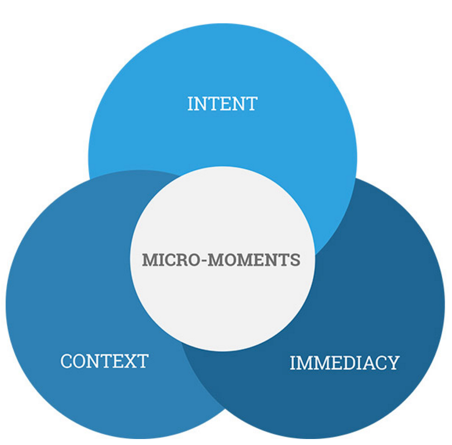
As a customer, think about a recent purchase and how you can fit this into the context of the list above. How did you search? Where did you search? What was the outcome?
Capturing Micro-Moments might seem like a daunting but task, but if you take the approach of breaking it down logically you'll actually find it pretty straight forward. Use these pointers to try and make sense of your Micro-Moments:
- Understand your audience
- Create the personas
- Mapping moments to personas and keyword research
- Competitor analysis
- Define the structure of the content
We're going to focus on the ‘be there’, ‘be useful’ and to a certain extent ‘be quick’ sections of the Micro-Moment - we can consider the way content is structured for mobile to ensure it's easily navigable and consumable.
Download our Micro-Moments template to get serious about identifying the moments important to your brand:

Understanding Audience
We put a huge focus on audience insights and content personas. Obviously, if you don’t understand your customer and their needs how can you expect to execute a successful content strategy to support your customer throughout the purchase funnel and ultimately increase conversions?
The bottom line is, you can't! So once we've defined these personas we can then begin to think about their individual needs in the buying cycle and aim to capture this traffic with content. Where can you gather such insight from? Here are a few simple examples:
1. Internal Data
The best place to begin with is with your own customer data. If you're lucky enough to have mosaic data or have done focus group research in the past, then use it. If not, then you can export sales/conversion data and segment it into persona related data where possible. As a top level example this could be age, gender, location and category of product purchased from. GA demographics will also help with further insight, of course.
2. Social Data
When it comes to audience understanding where better to look than at your social data? Also, don't overlook competitor data!
Personally, I think Facebook Audience Insights data accessed through the Ads Manager is brilliant for audience understanding and best of all - it's FREE! The tool should help with your Facebook Ad targeting better, however the data can also be used for persona creation and creating content that resonates with your audience other than product focused content. For a full step by step guide on how to leverage this data check out my colleague's post over on HubSpot.
3. YouGov Audience Profiler (Free Tool)
The YouGov Profiles tool can be used to get more insight on your audience. Just type in your brand, a larger competitor or a hobby/pastime and it returns loads of lovely rich data on your specific audience.
Persona Formulation
Each brand and website site will be different when thinking about the number of personas you are going to create. Time and resource also comes into play so you need to be realistic with what you can achieve and service properly, and also think about whether you need a persona set per category or whether you can use the same set across the business.
Concentrate on a sensible and productive number. Too many personas will only dilute what you are trying to achieve while just having one will lead to the content being too narrow and not appealing enough to the larger audiences. We normally look to use at least three and no more than five personas per category or business.
Below is an example on how to formulate these personas, plus a link to the template.
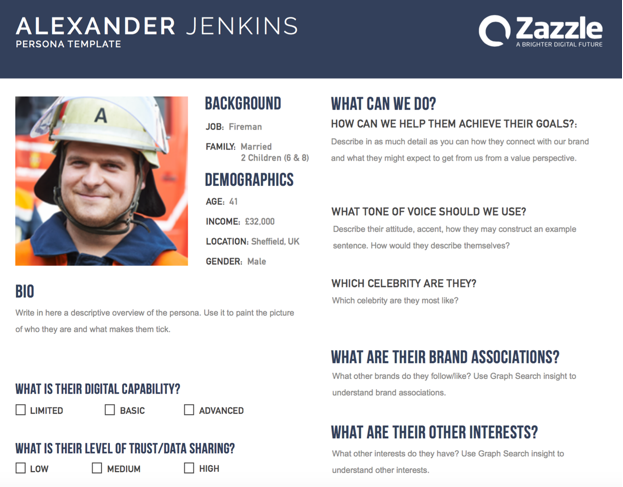
Competitor Analysis
SEM Rush is a pretty efficient way of checking not only what your competitors are ranking for but also any answer boxes they are currently owning. By searching for said competitor or website site, selecting organic research and positions, you can see the terms your competitor ranks for. This can then be exported and filtered.
The next level is to look at what Google Answer Boxes they're capturing. To view this, simply filter by SERP feature, and then featured snippet, and you'll see something like this:

Then sense check against the terms in the SERP:
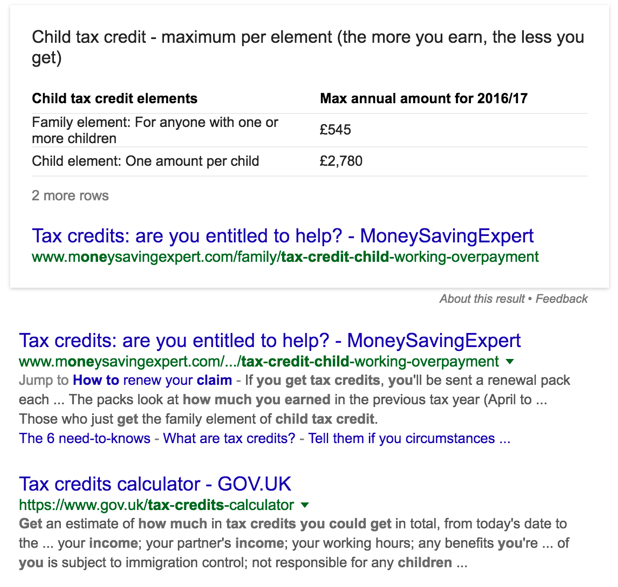
These Answer Boxes are appearing at the top of the organic results and capturing a lot of real estate in the SERP - great for awareness and capturing traffic at the top of the funnel. Google doesn’t automatically scrape the first result either; we’ve seen answer boxes being won by terms ranking within the top five. We’ve also seen great success with some of our clients utilising these, and with no ads down the side of the SERP there are some people speculating that this will allow extra space for the Knowledge Graph.
Mapping 'Moments' to Personas (be there/be useful)
Once the personas have been created we should understand their individual needs and how to ensure you have the right content for them, in their moment of need - no matter where they are in the purchase funnel. This is absolutely key to owning Micro-Moments as supplying customers with useful content at exactly the time they are looking or it will both increase brand advocacy and strengthen further awareness.
Choose one of your personas and think of queries that fall into each of the moments listed, again, below:
'Is it worth it?'
'Show me how'
'Time for a new one'
'Didn’t plan for this'
'One step at a time'
'Ready for a change'
'New day new me'
'I wanna talk to a human'
To capture these Micro-Moments, keyword formulation should be considered in a slightly different way to understand where the opportunity is, how the consumer will want to read the content, and ultimately how to structure that content to perfectly meet their needs.
Start by using AdWords planner to look at search volumes. To give you some inspiration on what longer-tail terms your audience might be searching for, a couple of really useful tools I’ve come across and use regularly are Answer The Public and LSI Graph. These deliver what, when, how, why and semantic phrases to your head terms, both of which churn out cool suggestions like this:
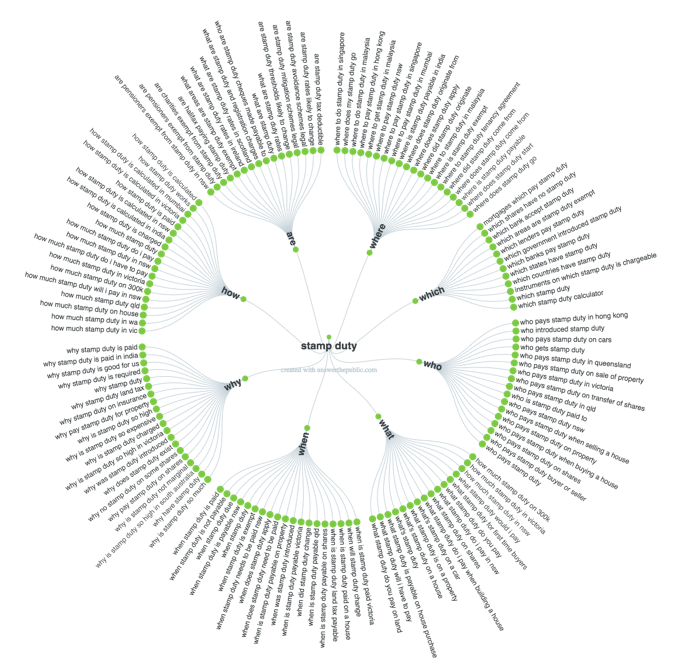
These terms should be considered when formulating functional content on product or category pages and also when creating blog strategies to capture this additional opportunity.
Admittedly, not all of these will be directly relevant to your customers but when you collectively understand and map these out, and then tie them back to your content personas, it will help inform your content strategy - and the content you create and distribute through owned, earned and potentially paid communication.
I've created a template below for an example persona and added it to the below free download:

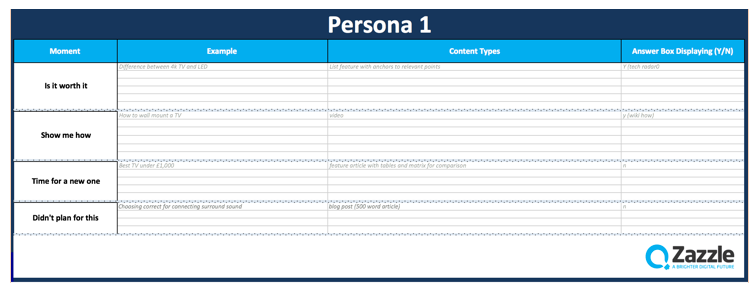
Content and Page Structure – ‘Be Quick’ and ‘Be Useful’
Content structure is a key reason why Google is displaying answer boxes from sites that have well designed pages which answer the question - quickly, efficiently and decisively.
Think back to the very beginning of this article and the information surrounding the change in search now being based around hundreds of real time, intent driven search queries. With that in mind, it’s therefore critical that you take a 'mobile first' view on these pages so that users can easily navigate to the part of content that answers their question - instead of having to infinitely scroll and scrabble around to find what they need. Isn't that infuriating?
This is an example of how to structure content well:
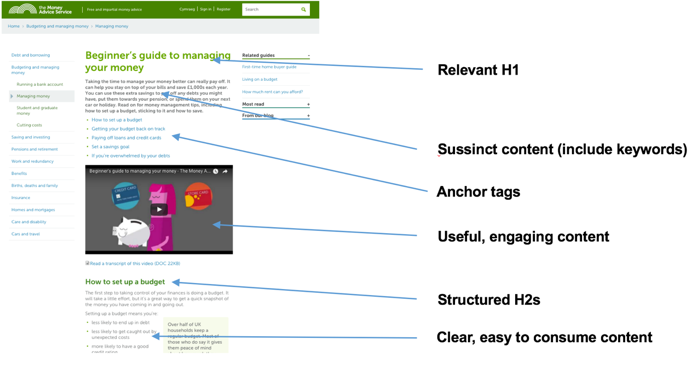
Instead of multiple pages to cover multiple Micro Moments, create pages that answer multiple queries around a similar topic or theme.
The page starts with the relevant H1 tag followed by some above-the-fold content that answers the users' query within just a couple of sentences. Then, if you have multiple questions or areas to cover in the page, pop these in a bullet pointed list with anchor tags that link to the relevant part further down the page. These ‘sub sections’ should be titled with a H2, with the detail being displayed clearly using tables and lists to make it easy to consume.
Conclusion
Getting the audience part right is the first big hurdle. However, once you get your personas properly nailed down, check on your competitors to see if anyone is really owning Micro-Moments and answer boxes and, of course, to see if you can take any inspiration from what you see. Your aim will be to do it better!
Use keyword research and some of the tools suggested to really define Micro-Moments and pinch points that your customers might be struggling with and map those to the personas to help prioritise your content creation.
Once you’ve made it that far, create and structure your content while always considering the following:
Be there
Be useful
Be quick
Sign up for our monthly newsletter and follow us on social media for the latest news.






 Proudly part of IPG Mediabrands
Proudly part of IPG Mediabrands